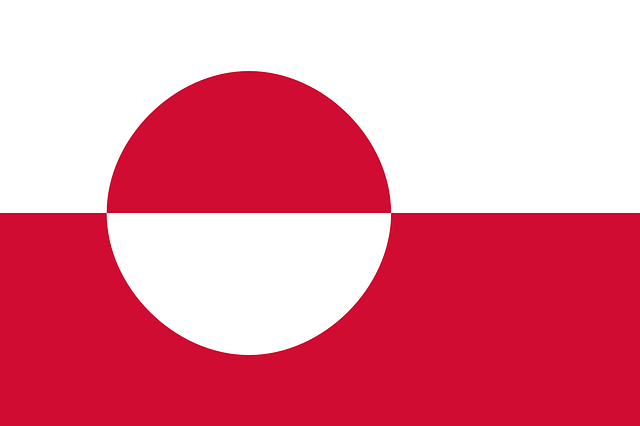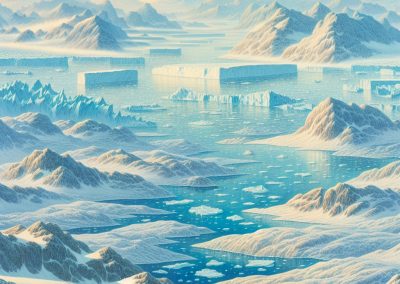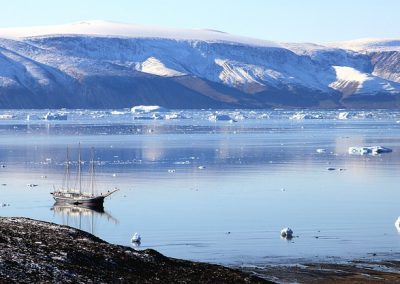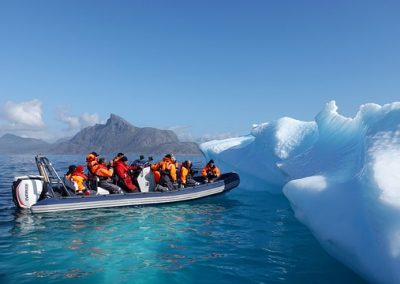Greenland
(Kalaallit Nunaat (Greenlandic))






Capital: Nuuk
Population (Estimated July 2012): 57,695
Area: 2,166,086 km2 or 836,330 mi2
Currency: Danish Krone (DKK)
Official Language: Greenlandic
Political Information: Constitutional Monarchy and Parliamentary Democracy
Official Religion: Lutheran Church of Greenland
Highest Mountain: Gunnbjørn Fjeld at 3694m or 12, 119ft
Largest River:
Time Zone (GMT/UTC): Between +/-0:00 and -4:00
Wildlife:
Counties/Provinces/States: 4 municipalities (kommuner, singular kommune); Kujalleq, Qaasuitsup, Qeqqata, Sermersooq
Leaders: Queen Margrethe II with High Commissioner Mikaela Engell and Prime Minister Kuupik Kleist
Greenland
Greenland, the world’s largest island, is an autonomous territory within the Kingdom of Denmark. Located between the Arctic and Atlantic Oceans, it is known for its stunning natural beauty, including vast ice sheets, towering mountains, and deep fjords. With a population of around 56,000 people, most of whom are indigenous Greenlandic Inuit, the island has a unique culture and way of life. Greenlandic, an Inuit language, is the official language, and the majority of the population is Christian, with a small minority practising Inuit spiritual beliefs. The capital city, Nuuk, is a vibrant hub of culture and commerce, while the rest of the island is sparsely populated, with small settlements scattered along the coast.
Greenland has a rich history dating back thousands of years, with evidence of human habitation going back to the Paleo-Eskimo people who first settled the island. In more recent history, Greenland was colonized by the Norse in the 10th century and later became a Danish colony in the 18th century. In 1979, Greenland was granted home rule by Denmark, and in 2009, it gained self-government, although it still relies on Denmark for defense and foreign affairs. The island’s economy is largely based on fishing, hunting, and tourism, with a growing focus on sustainable development and renewable energy. With its unique blend of natural beauty, rich culture, and fascinating history, Greenland is a truly special place that captivates all who visit.
Geography and Climate of Greenland
Greenland’s geography is dominated by its massive ice sheet, which covers about 80% of the island and is the second-largest ice sheet in the world after Antarctica. The ice sheet is up to 3 kilometres thick in some places and has a profound impact on the island’s climate and landscape. The coastline is dotted with deep fjords and towering mountains, including the highest peak in Greenland, Gunnbjørn Fjeld. The interior of the island is largely uninhabited and inaccessible due to the ice sheet, but the coastal regions are home to small settlements and towns.
The climate of Greenland is classified as Arctic, with long, cold winters and short, cool summers. The coastal areas experience milder temperatures due to the influence of the ocean, while the interior remains bitterly cold year-round. The island is also known for its strong winds and frequent storms, which can make travel and outdoor activities challenging. Despite its harsh climate, Greenland is home to a surprising variety of flora and fauna, including mosses, lichens, and hardy shrubs that have adapted to extreme conditions. The surrounding waters are rich in marine life, including whales, seals, and a variety of fish species. The unique geography and climate of Greenland make it a truly remarkable place to explore and experience.
History and Culture of Greenland
Greenland has a rich and diverse history that spans thousands of years. The island was first settled by Paleo-Eskimo people around 2500 BC, who lived a nomadic lifestyle based on hunting and fishing. They were later replaced by the Thule people, ancestors of the modern-day Inuit, who arrived around 1200 AD and established permanent settlements along the coast. In more recent history, Greenland was colonized by the Norse in the 10th century, who established several settlements before mysteriously disappearing around 1500 AD. In 1721, Greenland became a Danish colony, and over the centuries, Danish culture and influence have become deeply ingrained in Greenlandic society.
Today, Greenland has a unique and vibrant culture that blends traditional Inuit customs with modern Danish influences. The majority of the population is indigenous Greenlandic Inuit, who have their own language, traditions, and way of life. Traditional activities such as hunting, fishing, and dog sledging are still important parts of daily life for many Greenlanders, particularly those living in remote coastal communities. At the same time, modern conveniences such as internet access and mobile phones are widely available, and younger generations are embracing new opportunities for education and employment. The arts are also an important part of Greenlandic culture, with traditional music, dance, and storytelling playing a central role in community life. Despite its small population and remote location, Greenland has a rich and dynamic culture that continues to thrive in the modern world.
Wildlife and Natural Resources of Greenland
Greenland is home to a diverse array of wildlife and natural resources that are vital to the island’s economy and way of life. The surrounding waters are teeming with marine life, including whales such as humpback, minke, and bowhead whales, as well as seals and various species of fish. These marine resources have long been important to the indigenous Inuit people for food and materials for clothing and tools. In recent years, there has been growing interest in sustainable fishing practices to ensure the long-term health of these valuable resources.
On land, Greenland is home to a variety of Arctic animals such as polar bears, musk oxen, reindeer, Arctic foxes, and numerous bird species. The island’s flora is relatively sparse due to its harsh climate, but hardy plants such as mosses, lichens, and shrubs can be found in coastal areas. The natural resources of Greenland also include minerals such as zinc, lead, gold, iron ore, and rare earth elements. These resources have attracted interest from mining companies around the world, sparking debate about how best to balance economic development with environmental conservation.
The unique wildlife and natural resources of Greenland are essential to the island’s economy and way of life. They also play a crucial role in global ecosystems and are a source of fascination for scientists and nature enthusiasts alike.
Economy and Industry in Greenland
Greenland’s economy is largely based on fishing, hunting, and tourism, with a growing focus on sustainable development and renewable energy. Fishing is one of the most important industries in Greenland, providing employment for many people and supplying valuable seafood to international markets. The island’s waters are rich in fish such as cod, halibut, shrimp, and crab, which are caught using traditional methods as well as modern fishing techniques.
Hunting is also an important part of Greenland’s economy and cultural heritage. Indigenous Inuit people have long relied on hunting for food and materials such as fur and leather for clothing. While traditional hunting practices continue to be important for many communities, there are also strict regulations in place to ensure that hunting is sustainable and does not threaten endangered species.
In recent years, tourism has become an increasingly important part of Greenland’s economy. The island’s stunning natural beauty and unique culture attract visitors from around the world who come to experience activities such as hiking, dog sledging, whale watching, and northern lights tours. There is also growing interest in adventure tourism such as mountaineering and ice climbing. As tourism continues to grow, there is a focus on sustainable practices to protect the environment and preserve Greenland’s cultural heritage.
In addition to these industries, there is also growing interest in developing renewable energy sources such as hydropower and wind power to reduce reliance on imported fossil fuels. The economy of Greenland is diverse and evolving, with a focus on balancing economic development with environmental conservation.
Tourism in Greenland
Greenland’s stunning natural beauty and unique culture make it an increasingly popular destination for tourists seeking adventure and exploration. The island offers a wide range of activities for visitors to experience its breathtaking landscapes and rich cultural heritage. One of the most popular activities is hiking along the rugged coastline or through the interior mountains, where hikers can enjoy panoramic views of glaciers, fjords, and wildlife such as musk oxen and Arctic foxes.
Another popular activity is dog sledging, which has been an essential mode of transportation for the Indigenous Inuit people for centuries. Visitors can take guided tours across the ice sheet or through coastal regions while learning about traditional dog sledging techniques from local experts.
Whale watching is also a major draw for tourists visiting Greenland. The surrounding waters are home to numerous whale species that can be observed from boats or kayaks during the summer months. Visitors can see humpback whales breaching the surface or listen to the haunting songs of bowhead whales echoing through the fjords.
For those interested in cultural experiences, there are opportunities to visit traditional Inuit settlements to learn about their way of life and participate in activities such as seal hunting or traditional drum dancing. There are also museums and cultural centres in larger towns such as Nuuk that showcase Greenlandic art, history, and handicrafts.
As tourism continues to grow in Greenland, there is a focus on sustainable practices to protect the environment and preserve the island’s unique culture. With its diverse range of activities and awe-inspiring landscapes, Greenland offers an unforgettable experience for adventurous travellers seeking something truly extraordinary.
Challenges and Future of Greenland
Despite its natural beauty and rich cultural heritage, Greenland faces several challenges as it looks towards the future. One of the most pressing issues is climate change, which is having a profound impact on the island’s environment. Rising temperatures are causing glaciers to melt at an alarming rate, leading to rising sea levels that threaten coastal communities. Changes in sea ice patterns are also affecting marine wildlife such as polar bears and seals.
Another challenge is balancing economic development with environmental conservation. As interest grows in exploiting Greenland’s natural resources such as minerals and oil reserves, there is debate about how best to ensure sustainable development that benefits local communities without causing irreparable harm to the environment.
The small population size and remote location also present challenges for healthcare, education, and infrastructure development. Many communities lack access to basic services such as hospitals or schools due to their isolated locations.
Despite these challenges, there are also opportunities for positive change in Greenland’s future. The island has vast potential for renewable energy sources such as hydropower and wind power that could reduce reliance on imported fossil fuels. There is also growing interest in sustainable tourism practices that protect the environment while providing economic opportunities for local communities.
As Greenland continues to navigate these challenges and opportunities, there is hope that it can find a balance that preserves its natural beauty and cultural heritage for future generations to enjoy. With its unique blend of history, culture, and stunning landscapes, Greenland remains a truly special place that captivates all who visit.
FAQs
What is the location of Greenland?
Greenland is located in the North Atlantic Ocean, east of the Canadian Arctic Archipelago. It is the world’s largest island and is politically and geographically part of the continent of North America.
What is the capital of Greenland?
The capital of Greenland is Nuuk, which is located on the southwest coast of the island.
What is the climate like in Greenland?
Greenland has a polar climate, with long, cold winters and short, cool summers. The coastal areas are milder due to the influence of the ocean, while the interior experiences more extreme temperatures.
What is the population of Greenland?
As of 2021, the population of Greenland is estimated to be around 56,000 people. The majority of the population is indigenous Greenlandic Inuit.
What is the economy of Greenland based on?
The economy of Greenland is primarily based on fishing, mining, and tourism. The island is rich in natural resources such as minerals, including rare earth elements, and has the potential for hydroelectric power.
What languages are spoken in Greenland?
The official language of Greenland is Greenlandic, also known as Kalaallisut. Danish is also widely spoken and is the language of instruction in schools.
What is the government structure of Greenland?
Greenland is an autonomous territory within the Kingdom of Denmark. It has its own government and parliament, and is responsible for its own internal affairs, while Denmark handles foreign and defence matters.
Terrain and Topography of Greenland: mountains, valleys, and plains.
Greenland, the world’s largest island, is renowned for its stunning and diverse terrain and topography. The landscape of Greenland is characterized by its vast ice sheet, majestic mountains, deep valleys, and spectacular plains. The island’s terrain is a...
History of Greenland
Greenland has a rich history of human habitation dating back over 4,500 years. The first inhabitants of Greenland were the Paleo-Eskimos, who arrived in the region around 2500 BThese early settlers were a nomadic people who relied on hunting and fishing for their...
Population Density of Greenland
Greenland, the world’s largest island, is known for its stunning natural landscapes, including vast ice sheets, towering mountains, and deep fjords. Despite its immense size, Greenland has a relatively small population, with just over 56,000 people calling the...
Climate Zones of Greenland: Different climate regions Of Greenland
Greenland, the world’s largest island, is known for its diverse and extreme climate zones. The island’s climate is largely influenced by its high latitude and proximity to the Arctic Circle. Greenland is divided into several distinct climate zones, each...
Political Boundaries of Greenland: Provinces, Districts, or Historical Boundaries.
Greenland, the world’s largest island, is an autonomous territory within the Kingdom of Denmark. It is located between the Arctic and Atlantic Oceans, and its political boundaries have evolved over time. The island is known for its stunning natural landscapes,...
Natural Resources of Greenland: Where Natural Resources are Located in Greenland
Greenland, the world’s largest island, is known for its vast and diverse natural resources. From mineral deposits to oil and gas reserves, renewable energy potential, fisheries, aquaculture, forestry, and agriculture, Greenland is rich in natural resources that...
Cultural or Historical Sites of Greenland: Important Cultural Landmarks or Historical Sites In Greenland
Greenland, the world’s largest island, is a land of rich cultural and historical heritage. Its unique position between the North Atlantic and Arctic Oceans has made it a site of great importance throughout history. The island is home to a diverse range of...
























